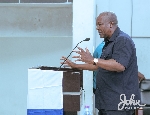Gov't to scrap 10,500 JHSs in 2023, make secondary education 6 years
 Education Minister Dr Yaw Osei Adutwum
Education Minister Dr Yaw Osei Adutwum
The government of Ghana is undertaking education reforms that will result in secondary school education being six years while the 13,000 junior high schools in the country are reduced to just 2,500.
This was announced by Education Minister Yaw Osei Adutwum on Tuesday, 14 December 2021.
At the heart of the ongoing reforms are science, technology, engineering and mathematics (STEM), Dr Adutwum noted.
“We’ve awarded contracts for about 15 schools that are going to be what we call lower secondary. The facilities we are providing [are] just like any high school facility and every one of those schools has a library, biology, chemistry and physics lab; beautiful school buildings and they are coming to a community near you very soon”, he announced.
“And, in 2023, when we open those schools, you are going to see how we are going to provide six years [of] quality secondary education and not three years plus some three years old middle-school-led education that we call high school”, he clarified.
Explaining the mechanics of the reforms using a practical example, Dr Adutuwm said: “If you go to Abenase and Onyuie, they have about 12 junior high schools. Within the next week or so, God willing, we’ll cut sod for the construction of a new lower secondary school there”.
“Now, all those 12 schools will be out of commission a year from now”, he noted, explaining: “They’ll no longer exist as junior high schools; we’ll move all the students into this new building that has biology, chemistry and physics labs, libraries and everything”.
Therefore, he pointed out, “these students who are now going to grow up in Onyuie or Abenase are going to get the highest level of science education: Robotics is going to be taught there, the space is provided for that and their level of proficiency, by the time they get to junior high three, will be very different”.
“But the good news about that is instead of 12 headmasters, we are going to have one”.
“So, we have 13,000 junior high schools; if these reforms go on as planned, we are going to reduce that to about 2,500”, he added.
Dr Adutwum mentioned that “with the government pursuing strategies aimed at increasing the Gross Tertiary Enrollment Ratio (GTER) from the current 18.84% to 40% by 2030, it is in our interest to continuously expand the infrastructural base of the various tertiary institutions”.
“We are all aware of the many ongoing projects on our tertiary campuses, some of which have been abandoned for years, while others are in urgent need of additional government funding for completion”.
Source: classfmonline.com
Trending News

Sign Ghana National Service Authority Bill into law – NSS begs Akufo-Addo
10:53
MoH receives first batch of donated medical supplies after a year-long port delay
02:51
Akufo-Addo and Ouattara inaugurate Côte d'Ivoire-Ghana Cocoa Initiative Secretariat today
07:45
Geopolitics split African states’ response to Iran-Israel tension
10:37
Jefferson Sackey advocates peace and tolerance at Eid-ul-Fitr celebration
02:04
Akufo-Addo commissions Kumasi Thermal Power Plant and Genser Energy Kumasi Pipeline
06:27
Gov’t releases ₵26m to institutional suppliers
11:52
PAC orders East Gonja Municipal Assembly to pay contractor GHS92,704 with interest
06:09
Feeding grants'll be paid directly to school heads in my next gov’t – Mahama promises
11:02
Lack of public purse protection ‘pathetic’ – Sam Jonah calls out ‘weaponisation of state agencies against opponents, assault on press freedom'
04:02



